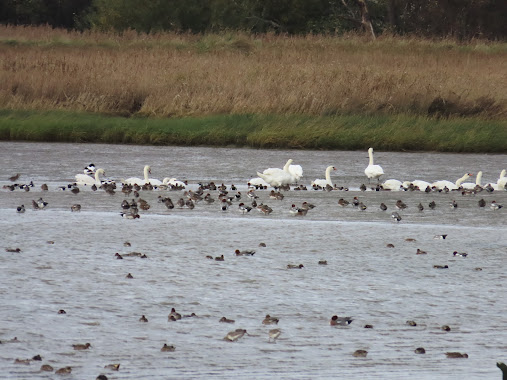Once upon a time Hazelwood Marshes was a quiet area of grazing marsh that lay beside the River Alde. However with the floodings of 2013, the river wall was breached and the area was inundated, and when that ended it was deemed too difficult to rebuild and was left. As a result Hazelwood Marshes became an area of tidal estuary, just like the neighbouring river. And its actually a better birdwatching site because of it. You always rely on nature to heal itself, its only when humanity intervenes that things get bad.
The Sailor's Path treads its way from Snape down to Aldeburgh, four kilometers long and passing through a large range of habitats, from extensive heaths and woods to lots of wetlands. It was quiet bird-wise as I wound my way down, and it was only when I hit Hazelwood that things really kicked off. On the Marshes the tide was half out and was receding. Near the tide line an extensive area of reeds was growing, this valuable habitat can survive in brackish as well as fresh water. A line of dead birch trees marked the height of the tidal zone, trees that used to grow on dry land before the inundation.
The hide sits at the top of the Marshes and gives a good lookout over Hazelwood on one side and the River Alde behind on the other. Its the only view of the estuary in the area and a good birdwatching site. The walk to the hide passes one side of the Marshes and there were at least three ROCK PIPIT present beside the path. From an initial look out on the estuary there were plenty of birds on the mudflats. A more advanced look showed up DUNLIN as the most numerous, this small wader fed in large, tight flocks, with a few similar sized RINGED PLOVER among them. There was also a flock of GODWIT and plenty of REDSHANK and CULREW, the latter birds tend to be single or in loose flocks. GREY PLOVER were also present in small numbers and singles of TURNSTONE and OYSTERCATCHER were also around.
Out on the River Alde the tide was slightly higher, which had pushed the birds nearer to me in the hide. There were thousands of TEAL and WIGEON, and a large herd of 80 MUTE SWANS present, good numbers for this area of the estuary. They lingered mainly on the water just off the tideline. I whiled away half an hour in the hide before walking the Sailor's Path back to Snape. Not a particularly remarkable day, but one of quiet interest, which is what a lot of birdwatching is about.
With such a quiet Winter so far, with so few influxes of waterbirds to our wetlands, it was good to see large numbers present at Hazelwood Marshes today. Estuaries rarely get the accolade that a lot of other birding places receive. Maybe because they can be so distant and birdless at the wrong tide times, maybe because they are a land that is of no use to humans, but they are home to thousands of birds. And when you get the tide times right you can experience some of the greatest bird spectacles in this country. They are truly special.





No comments:
Post a Comment